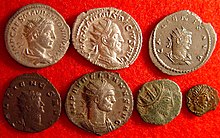Antoninian
The Antoninian was an ancient Roman silver coin that was introduced as an official currency under Emperor Caracalla (211–217) around 214 AD.
The ancient name of the coin has not been passed down. The name Antoninian is derived from the actual name Caracallas, Marcus Aurelius Antoninus, and was introduced in the Middle Ages . According to recent research, the ancient name of the Antoninian is said to have been Bicharactus .
The Antoninian became the most popular coin in the 3rd century due to galloping inflation and was only replaced by Diocletian's coin reform at the end of the 3rd century. In the meantime Aurelian had tried to stabilize the Antoninians.
The Antoninian had a nominal value of two denarii and at the beginning of the minting a weight of about 5.5 grams. Calculated according to the fineness of silver, however, it was only 1½ denarius from the start. Over time, the weight and silver content continued to decrease, so that by the end of the century it was just a tiny bronze coin without any silver content.
The most striking feature of the Antoninian was the crown of rays on the image of the ruler and the crescent moon under the image of the empress. For around two centuries these symbols have been minted as features of double coins on Roman coins, for example on the Dupondius .
literature
- Wilhelm Kubitschek : Antoninianus 2 . In: Paulys Realencyclopadie der classischen Antiquity Science (RE). Volume I, 2, Stuttgart 1894, Sp. 2568-2571.
Web links
Remarks
- ^ So Bernd Sprenger: Das Geld der Deutschen , 3rd edition, Schöningh, Paderborn 2002, p. 31.
